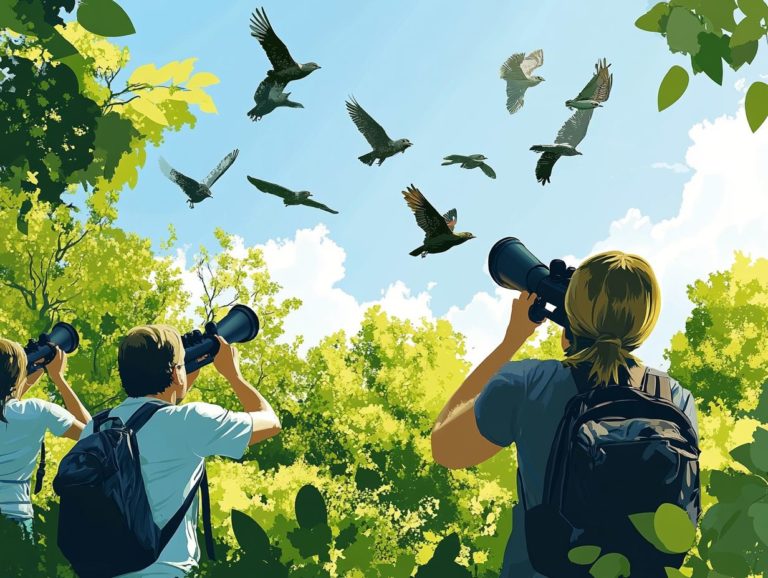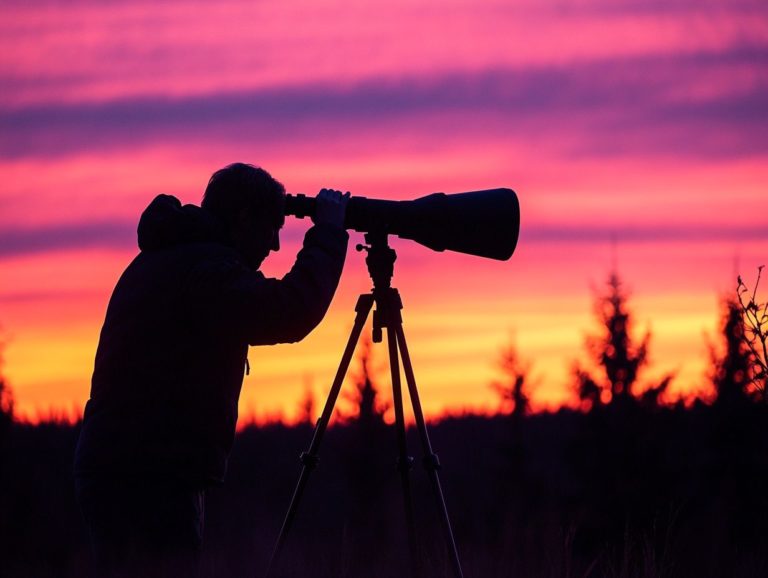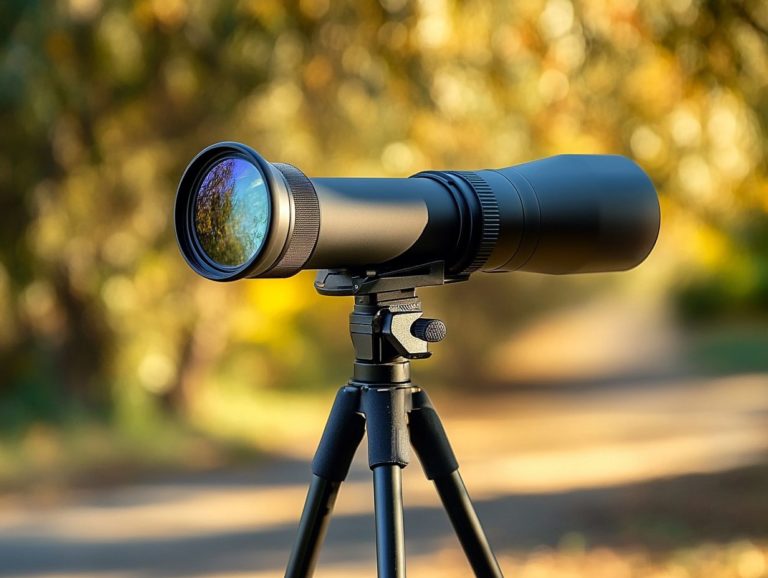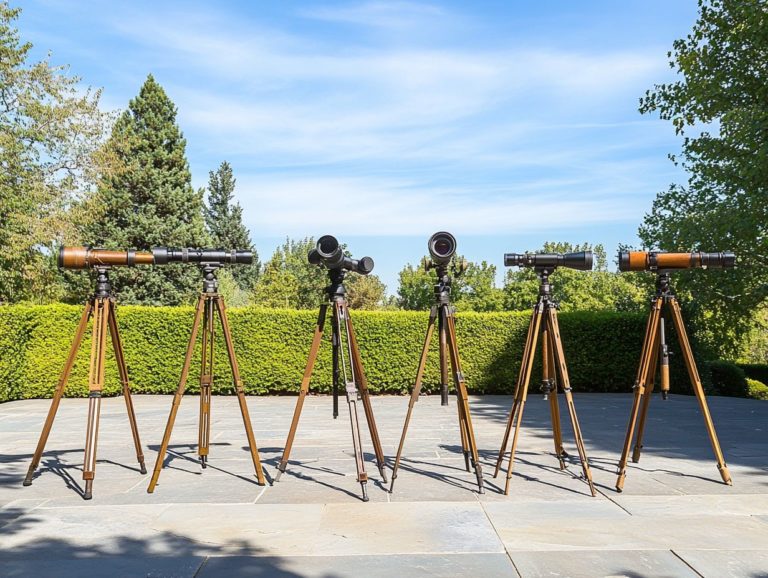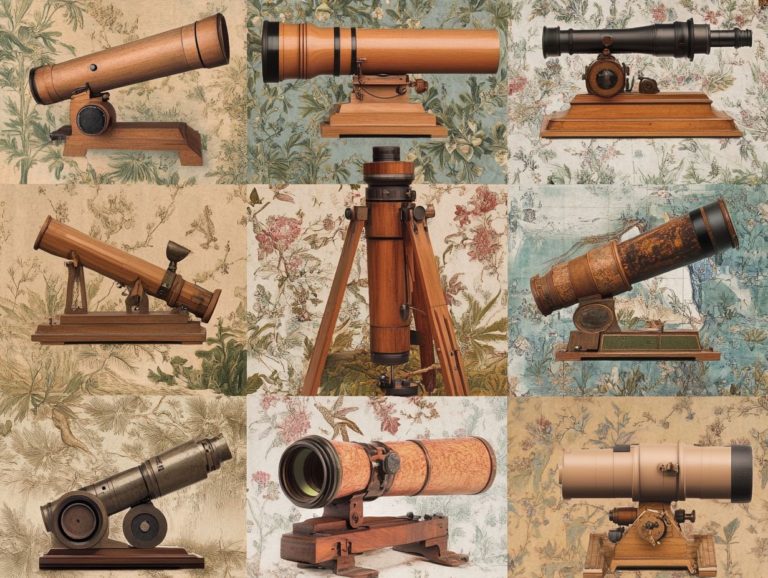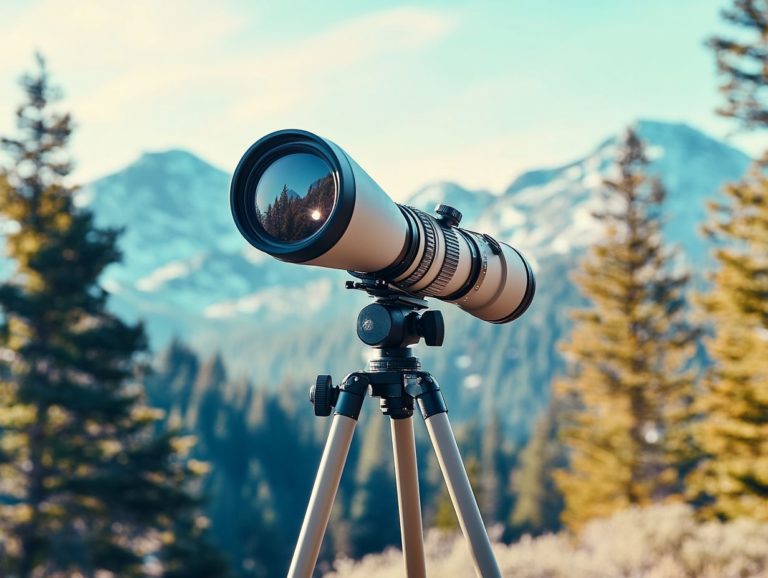Choosing the Best Spotting Scope for Coastal Birding
Coastal birding presents a remarkable opportunity for you to observe a diverse array of bird species in their natural habitats. However, having the right tools can truly elevate this experience.
A quality spotting scope is essential for capturing distant birds in stunning detail. You ll discover the benefits of using a spotting scope, what features to consider when selecting one, and top recommendations specifically tailored for coastal environments.
You will find valuable tips to enhance your birding adventures while ensuring your equipment remains in peak condition. Get ready to revolutionize your coastal birding adventure!
Contents
- Key Takeaways:
- Benefits of Using a Spotting Scope
- Factors to Consider When Choosing a Spotting Scope
- Recommended Spotting Scopes for Coastal Birding
- Tips for Using a Spotting Scope in Coastal Environments
- Frequently Asked Questions
- Why Choosing the Right Spotting Scope Makes Coastal Birding Unforgettable!
- What Features Should I Look for When Choosing a Spotting Scope for Coastal Birding?
- What is the Recommended Magnification for Coastal Birding?
- Is a Tripod Essential for Coastal Birding with a Spotting Scope?
- Can I Use a Regular Camera Tripod for My Spotting Scope?
- What Brands or Models are Recommended for Coastal Birding?
Key Takeaways:
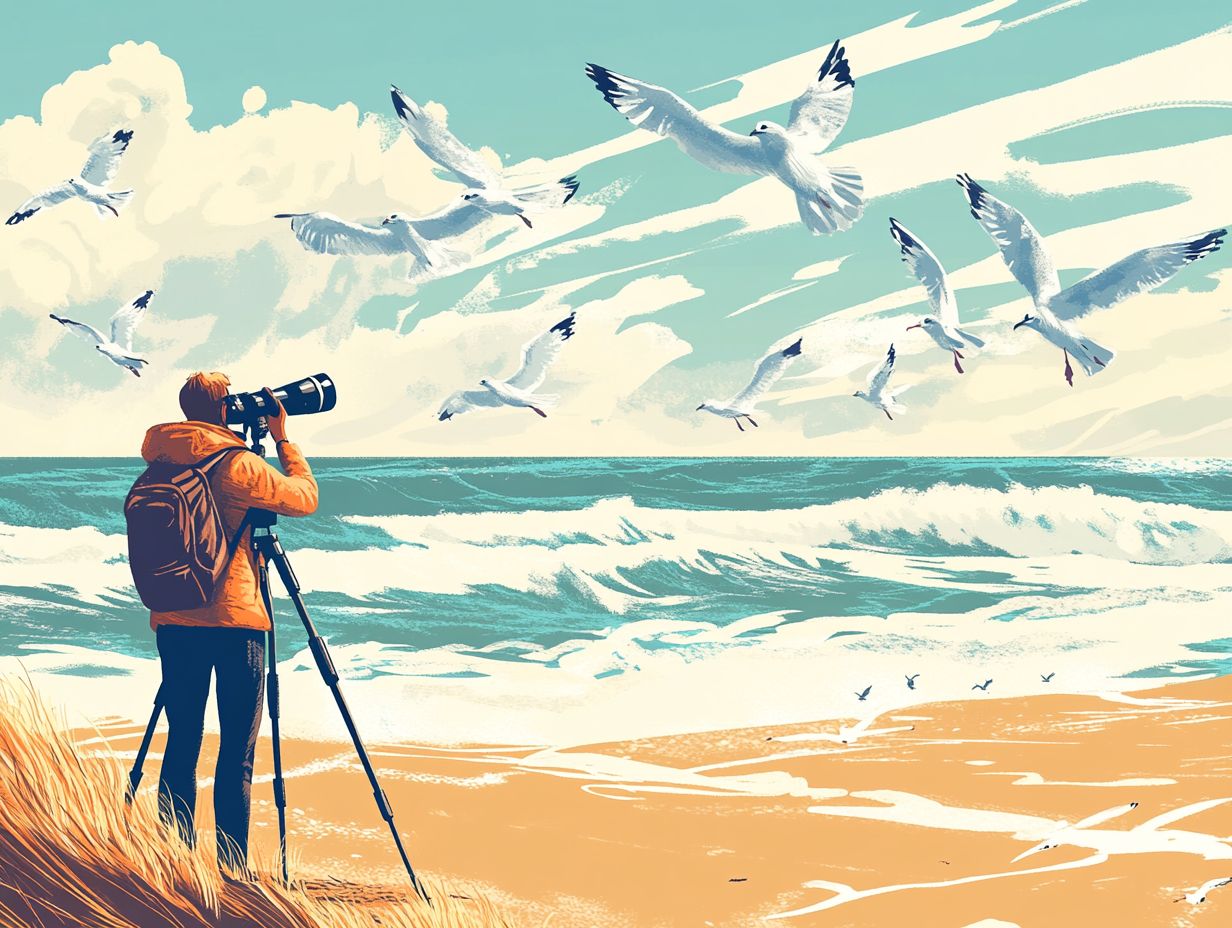
- Investing in a high-quality spotting scope can greatly enhance your coastal birding experience, allowing you to see and identify birds in greater detail and from farther distances.
- When choosing a spotting scope for coastal birding, consider factors such as optics quality, magnification and zoom range, and weatherproofing and durability to ensure the best performance in oceanfront environments.
- Proper maintenance and care, as well as adjusting for glare and light reflection, are important tips to keep in mind when using a spotting scope for coastal birding to ensure optimal viewing conditions and longevity of your equipment.
What is Coastal Birding?
Coastal birding offers a unique experience that allows you to immerse yourself in the beauty of bird species inhabiting coastal habitats like estuaries, beaches, and marshes. The way land and sea come together creates a rich tapestry of birdwatching opportunities.
Here, you can glimpse remarkable species such as the Curlew, Egret, Wigeon, and Osprey. To elevate your birding experience, consider investing in high-quality spotting scopes and binoculars.
Brands like Nikon or Vortex enable you to identify field marks and observe behaviors from a comfortable distance. This practice not only enhances your understanding of migratory patterns and nesting behaviors but also plays a vital role in conservation efforts by emphasizing the significance of these fragile ecosystems.
While birding, you may come across species like the Roseate Spoonbill and Black Skimmer, both of which serve as indicators of environmental health. Organizations like the Cornell Lab of Ornithology provide invaluable research and resources.
Local birding clubs organize events to promote community involvement. Destinations such as Cape May and Point Reyes draw both novice and experienced birders, offering countless opportunities for learning and collaboration.
Through these collective efforts, you help ensure that future generations can also relish the splendor of coastal birdlife.
Benefits of Using a Spotting Scope
Utilizing a spotting scope transforms your birdwatching experience, offering remarkable light-gathering capability and crystal-clear image details. This allows you to observe even the most elusive bird species in their natural habitat with ease.
These birding scopes elevate the quality of close-up viewing, making them essential tools for both novice and seasoned birdwatchers alike.
Enhanced Birding Experience
The enhanced birding experience you gain from spotting scopes compared to traditional binoculars lies in their exceptional sharpness and brightness. This clarity allows you to appreciate the intricate details and vibrant colors of various bird species.
This is crucial for identifying field marks, especially during coastal birding. For more information on choosing the right equipment, consider spotting scope selection factors as they typically come equipped with advanced zoom eyepieces and larger objective lenses, which significantly enhance light-gathering capabilities.
This means you can enjoy a more vivid observation experience, particularly in low-light conditions. The high-density glass used in these scopes further elevates image quality, ensuring that every feather and subtle coloration is clearly visible.
When you weigh the options between binoculars and scopes, you’ll often find that serious birders prefer the latter. With higher magnification and improved stability, scopes allow for extended viewing sessions without straining your eyes.
In essence, if you’re dedicated to observing avian life, scopes offer an unparalleled advantage in both clarity and detail.
Factors to Consider When Choosing a Spotting Scope
When you re selecting a spotting scope, it s vital to consider key factors now for the best birdwatching experience! Focus on specifications like magnification power, focusing mechanism, and durability.
Choosing wisely can significantly elevate your birding experience, allowing for optimal performance in diverse environments, especially when you’re observing coastal bird species. For more guidance, check out how to find the right spotting scope for your needs.
Optics Quality
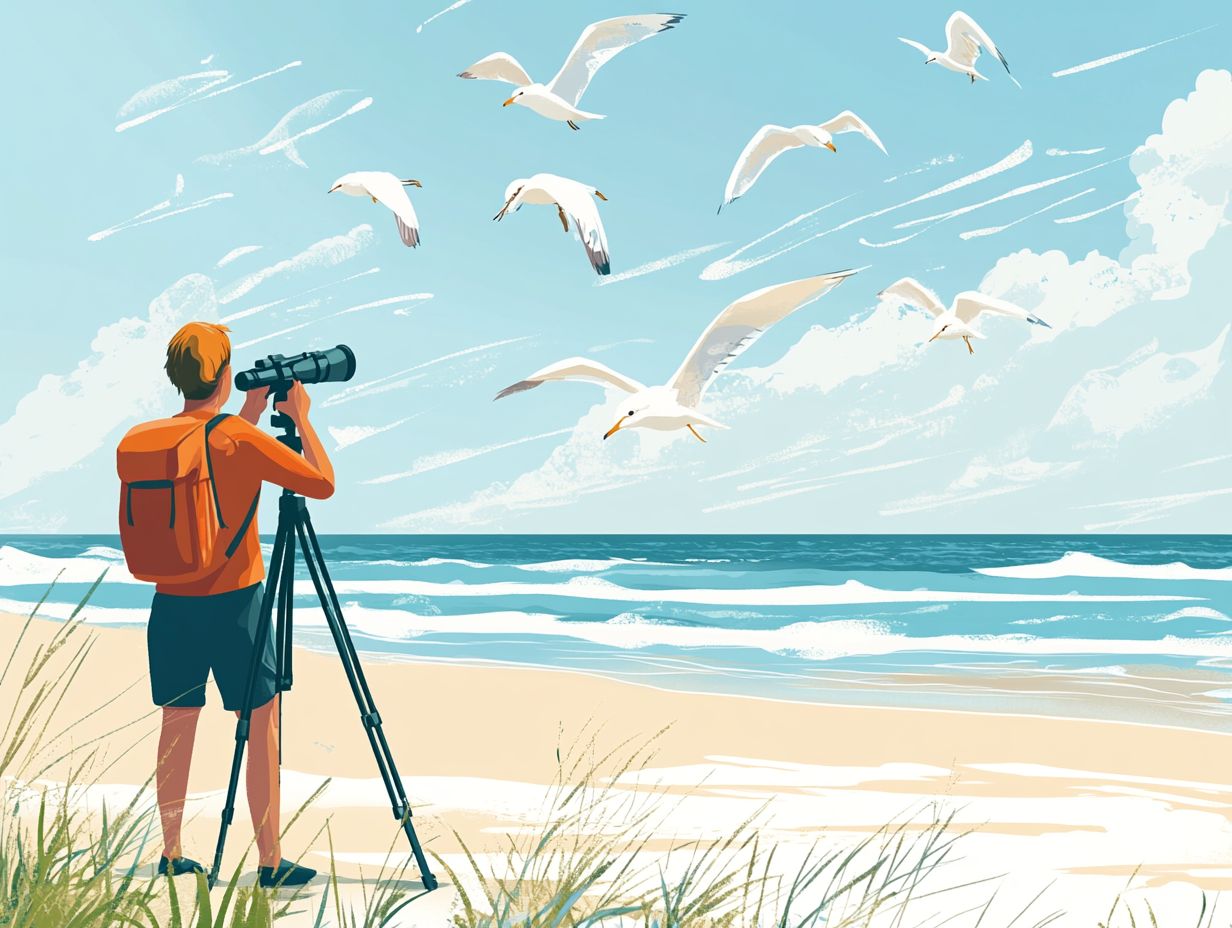
The quality of optics in a spotting scope is paramount, providing a clear and vibrant view of distant birds. This often involves advanced materials like high-density glass and extra-low dispersion lenses. To fully appreciate these features and learn how to use a spotting scope for bird identification, it’s essential to understand how they work together to minimize color distortion and enhance color accuracy, perfect for coastal birding adventures, focusing on sharpness and brightness.
When the optics are finely tuned, you re rewarded with crystal-clear images and true-to-life colors that beautifully reflect the striking plumage of your feathered subjects. Brands like Nikon and Vortex exemplify their dedication to superior optics standards. For instance, Nikon s ED (Extra-low Dispersion) glass effectively reduces color fringing, while Vortex s premium coatings maximize light transmission, ensuring enhanced brightness even in low-light conditions.
This careful attention to detail ensures you won t miss any nuances in the birds feathers and behaviors. Investing in high-quality optics transforms a simple birdwatching outing into an immersive experience, making it an essential aspect for any serious birding aficionado like yourself, especially on sites like Birdwatching-bliss.com.
Magnification and Zoom Range
Magnification power and zoom range are essential elements of spotting scopes, allowing you to identify field marks at various distances. A high-quality spotting scope can provide a magnification range that enables you to transition seamlessly from wide-angle views to close-up views.
This versatility becomes particularly crucial during your birdwatching adventures; the ability to adjust the zoom at a moment’s notice can mean the difference between a fleeting glimpse of a distant bird and a captivating look at its unique features up close.
While higher magnifications can reveal fine details, they often bring their own set of challenges. You might encounter stability issues that necessitate a sturdy tripod for scopes to counter shakes that detract from your viewing experience. Increased magnification can also lead to light loss, especially in low-light conditions, which can compromise overall image clarity.
Thus, while zoom eyepieces enhance usability, it s important for you to find a balance between magnification and the practicalities of your viewing conditions.
Weatherproofing and Durability
When you’re birdwatching in coastal environments, choosing a waterproof spotting scope is essential. For guidance on selecting the perfect one, check out how to choose the right spotting scope for you. Its resilience against harsh weather ensures reliable performance throughout your adventures, especially during unpredictable coastal weather.
A robust, weatherproof design protects the optics and enhances longevity, making it a crucial asset for any dedicated birder. Fog resistance is another critical factor when navigating the typical temperature and humidity fluctuations of coastal regions.
A fog-resistant scope allows you to maintain clear visibility and focus, even when the weather plays tricks, further enhancing your birdwatching adventures.
The overall build quality is equally important; durable materials can withstand saltwater exposure and high winds that would easily compromise lesser models. All these features work together to improve usability and enhance your experience of the diverse avian activities around you, regardless of challenging coastal conditions, especially with quality lenses that elevate your viewing experience.
Don t wait experience birdwatching like never before!
Recommended Spotting Scopes for Coastal Birding
When you’re searching for the best spotting scopes for coastal birding, a few brands truly shine. Nikon and Vortex are renowned for their superior quality and outstanding performance, especially when used at top bird watching locations!
Retailers like B&H Photo provide an extensive selection tailored to diverse needs, ensuring you can find the ideal scope to elevate your birdwatching experience.
Top Brands and Models
Some top brands in spotting scopes are Nikon and Vortex. Each brand offers a range of models designed specifically for birding enthusiasts. Whether you’re after high-end lenses or more budget-friendly choices, these brands deliver reliable performance and exceptional clarity, especially for coastal birding. For those interested in birding, knowing how to choose binoculars for long-distance birding can enhance your experience even further.
Take the Nikon Prostaff 5, for example. Its compact design and impressive light transmission make it an ideal companion for spotting elusive coastal species, even in low-light conditions. The Vortex Diamondback series shines with its rugged construction and waterproof features, ensuring you re well-equipped for any outdoor adventure.
Users often rave about the ease of use and clarity these scopes provide. You ll appreciate the intricate details of distant birds. Many birdwatchers praise the lightweight design of these models, making travel a breeze while still enjoying sharp images and vibrant colors essential for a fulfilling birding experience!
Tips for Using a Spotting Scope in Coastal Environments
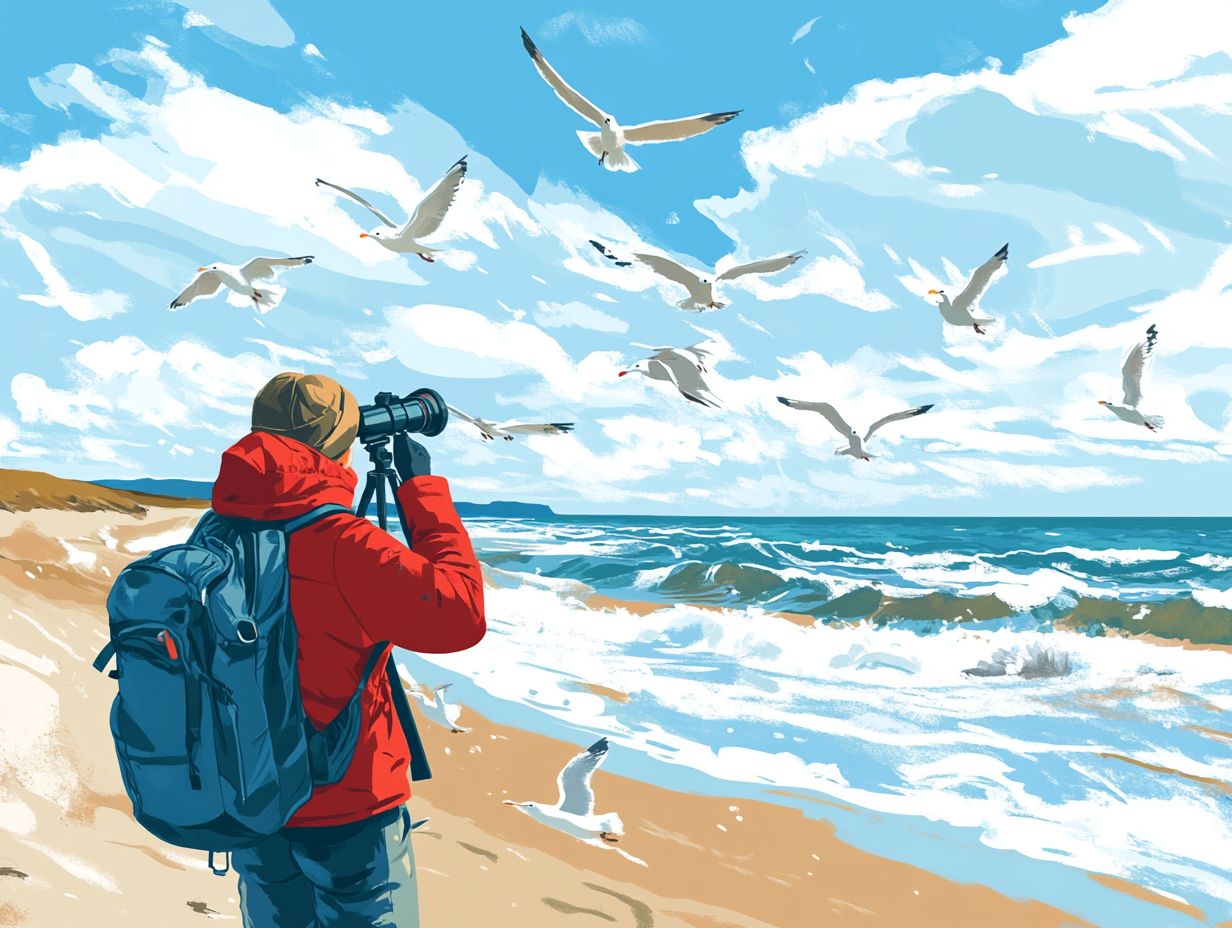
Using a spotting scope in coastal environments involves specific techniques that cater to the unique challenges of these areas. It’s important to focus on maintaining your equipment and making necessary adjustments for glare and light reflection. Additionally, knowing the top features to look for in a spotting scope can significantly enhance your experience.
Mastering these tips not only enhances your viewing pleasure but also extends the lifespan of your spotting scope, ensuring it serves you well for many adventures to come.
Proper Maintenance and Care
Maintaining your spotting scope is essential for long-term durability and optimal performance, especially if you frequently use it in coastal environments. Regularly clean the objective lens and eyepieces, and check for water damage to extend the life of your equipment.
These practices also include using a soft microfiber cloth to gently wipe the lenses. This will help prevent scratches that can impair your vision. It s best to use a dedicated lens cleaner specifically formulated for optics to remove smudges without causing any damage.
When storing your scope, keep it in a protective case that shields it from dust, salt air, and extreme temperatures.
These simple yet effective maintenance techniques not only protect your scope but also enhance its performance, making it a worthwhile investment for any outdoor enthusiast!
Adjusting for Glare and Light Reflection
Adjusting for glare and light reflection is vital for birders using a spotting scope in coastal environments. Sunlight can turn the simplest viewing into a challenge. By utilizing lens hoods and adjusting the angle of your scope, you can significantly enhance visibility and elevate your birdwatching experience. For those looking to improve their gear, choosing the right binoculars for bird watching can also make a significant difference.
To amplify your viewing capabilities, consider using polarized lens filters. These effectively cut down glare by minimizing the light bouncing off reflective surfaces like water, making it easier to spot elusive birds.
Placing your scope at the optimal height also plays a crucial role; it allows for better alignment with both the bird s position and the sun s angle. Don t underestimate the power of timing try different times of day for improved sightings. Early mornings and late afternoons typically offer softer light, perfect for spotting and identifying diverse species!
Incorporating these techniques will transform your coastal birdwatching into a more fruitful and enjoyable endeavor.
Frequently Asked Questions
To learn more about the best spotting scopes and tips for birdwatching, check out our recommended products and guides!
Why Choosing the Right Spotting Scope Makes Coastal Birding Unforgettable!
Choosing the right spotting scope for bird migration transforms your birdwatching adventure! You’ll witness stunning details of birds in their natural coastal habitats.
What Features Should I Look for When Choosing a Spotting Scope for Coastal Birding?
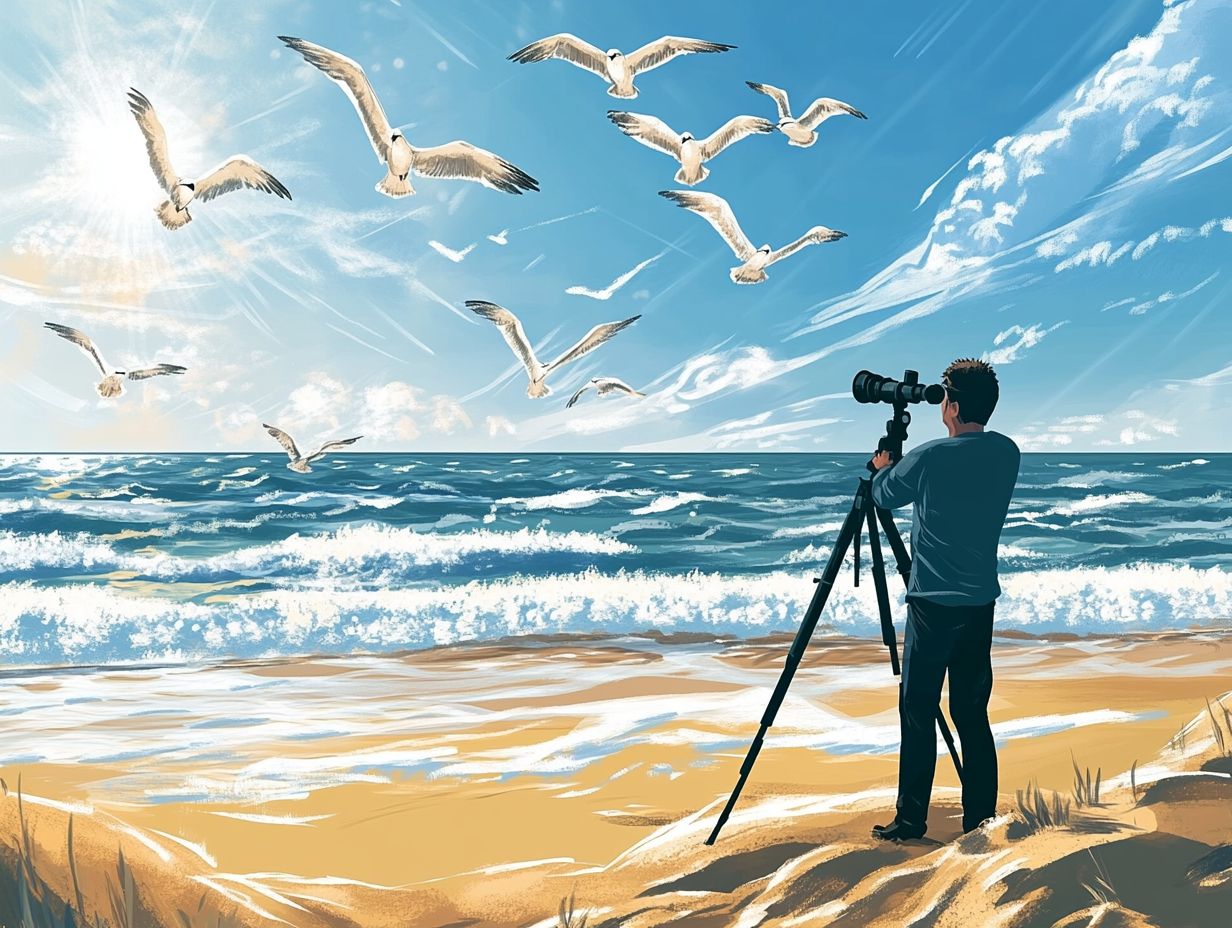
Some important features to consider are magnification, which helps you see distant birds clearly, and lens diameter, which affects how much light enters the scope. Also, look for waterproof and fog-proof capabilities to protect your scope from coastal weather.
What is the Recommended Magnification for Coastal Birding?
Choose a spotting scope with at least 20x magnification. This allows you to see birds in detail while maintaining good image quality.
Is a Tripod Essential for Coastal Birding with a Spotting Scope?
A tripod is essential for stable viewing. Coastal winds can make it difficult to keep the scope steady, so a tripod helps prevent shaky images and reduces eye strain.
Can I Use a Regular Camera Tripod for My Spotting Scope?
It s best not to use a regular camera tripod for a spotting scope. These tripods often lack the sturdiness needed to support the weight and size of a spotting scope, so invest in one designed specifically for spotting scopes.
What Brands or Models are Recommended for Coastal Birding?
Reliable brands for spotting scopes include Vortex, Kowa, and Swarovski. Research and read reviews to find the best model that fits your budget and needs.
Now that you’re equipped with essential tips, grab your spotting scope and head to the coast for an adventure you’ll never forget!

